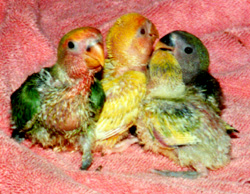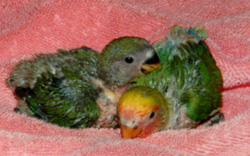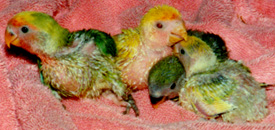![]()
I can't believe how far we've come in less than a year!
Why did I call this section "Dipping into the Paint Box"? Because that's what I felt like I was doing each time I reached into Larry & Diva's nestbox! I can't get over the beauty and variety of colours they have provided us with in their babies.
You may notice in these pictures that some of the babies show black on their beaks. This is an indication of a juvenile bird, and that fades away over time. Some colour mutations (such as the lutino) don't show any colour on their beaks even as juveniles, and some (such as pieds) may show less black or none at all. With certain colours though, this would tell you if the baby you're getting is still very young.
Interested in more info on our birds or Aviary?
Previous Page
 I was one of those people who bought their birds without doing any research on them beforehand - I'm shocked at myself for having done that now. Before the first eggs hatched, I'd read enought to know that two pied green parents should produce pied green and normal green babies. We waited expectantly for the results. We were totally unprepared for the little jade green and dutch blue babies. Where did those changelings come from?
I was one of those people who bought their birds without doing any research on them beforehand - I'm shocked at myself for having done that now. Before the first eggs hatched, I'd read enought to know that two pied green parents should produce pied green and normal green babies. We waited expectantly for the results. We were totally unprepared for the little jade green and dutch blue babies. Where did those changelings come from?
 Closer examination of Diva's rump indicated he carried the dark factor that created the jade baby. I'd always known they had different coloured rumps, I just hadn't realized that meant something! I now discovered that both birds had to be split for blue as well to get a blue line bird from this pairing. Being "split" for the colour meant they carried the gene without showing it visually.
Closer examination of Diva's rump indicated he carried the dark factor that created the jade baby. I'd always known they had different coloured rumps, I just hadn't realized that meant something! I now discovered that both birds had to be split for blue as well to get a blue line bird from this pairing. Being "split" for the colour meant they carried the gene without showing it visually.
 The second clutch, which hatched 4 babies this time (pictured on this page), produced what we thought at first was a lutino baby, because she had no green feathers at all and red eyes. I knew that would mean that Diva had to be split for lutino because females (and therefor Larry) can't be split for this factor - if they have it they show it. Because of the way this mutation is inherited, that also meant the baby had to be a female.
The second clutch, which hatched 4 babies this time (pictured on this page), produced what we thought at first was a lutino baby, because she had no green feathers at all and red eyes. I knew that would mean that Diva had to be split for lutino because females (and therefor Larry) can't be split for this factor - if they have it they show it. Because of the way this mutation is inherited, that also meant the baby had to be a female.
 You would think I'd be estatic about this, and on one level I was, on another I was dismayed at the thought of trying to identify so many types of babies with so little experience. The genetic calculator at the African Lovebird Society web site told me Larry & Diva could produce 48 different types of babies (it counts female and male of the same colour as 2 different types because some factors - such as lutino - will only produce one sex of bird in certain combinations)
You would think I'd be estatic about this, and on one level I was, on another I was dismayed at the thought of trying to identify so many types of babies with so little experience. The genetic calculator at the African Lovebird Society web site told me Larry & Diva could produce 48 different types of babies (it counts female and male of the same colour as 2 different types because some factors - such as lutino - will only produce one sex of bird in certain combinations)
 As this little chick grew, I was concerned that her flights weren't as white as I thought they should be. Shortly after that, we purchased another lutino, and there was a big difference in the flight and tail feather colours. Pouring over the books again, and asking for assistance "on-line", I've established that our little gal is probably actually an American Yellow Australian Ino. If you know colour mutations well, please take a look at our "Mystery Bird" and offer us your opinion! She is shown in these group photos as well at about 3 weeks old. She's the yellow one with red eyes!
As this little chick grew, I was concerned that her flights weren't as white as I thought they should be. Shortly after that, we purchased another lutino, and there was a big difference in the flight and tail feather colours. Pouring over the books again, and asking for assistance "on-line", I've established that our little gal is probably actually an American Yellow Australian Ino. If you know colour mutations well, please take a look at our "Mystery Bird" and offer us your opinion! She is shown in these group photos as well at about 3 weeks old. She's the yellow one with red eyes!
Please e-mail us!
![]() What's in Store for
What's in Store for
Song of the Serengetti Aviary in '98
![]()
![]() Get your own Free Home Page
Get your own Free Home Page